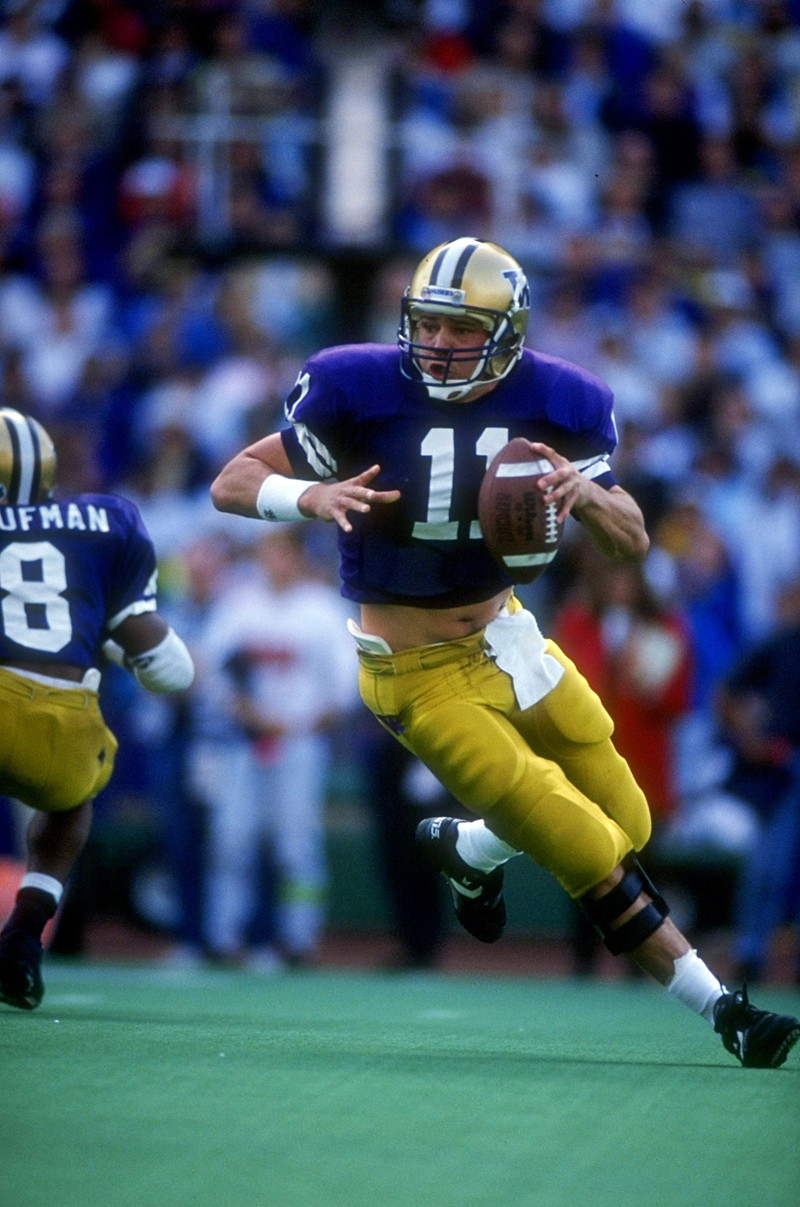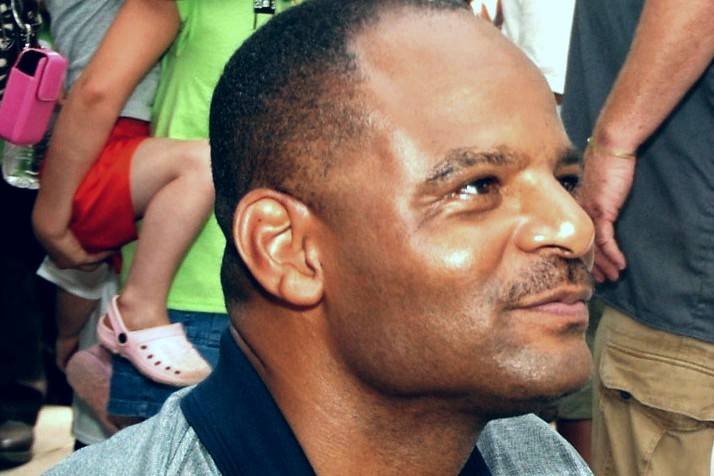By 2005, after 13 seasons in the National Football League, former University of Washington quarterback Mark Brunell was getting older and better. As a 35-year-old Washington Redskin, he passed for more than 3,000 yards and 23 touchdowns. In a Monday Night Football game, the 6’1″, 215-pound veteran coolly delivered two long TD passes to Santana Moss in the final minutes to beat the Dallas Cowboys 14-13. His strong arm led Washington to the playoffs, losing to the Seattle Seahawks but earning him a third-place finish in the vote for NFL Comeback Player of the Year.
The three-time Rose Bowler was also near the pinnacle of his earnings career, making $9.4 million with the Redskins in 2004, a considerable jump from the $6.7 million he’d made the previous year at Jacksonville, where he’d been the Jaguars’ starting quarterback for eight years, earning a Pro Bowl MVP award.
Married with four children, Brunell owned luxury properties, operated several businesses (including a football camp), and had invested a fortune in real estate. He’d become a multimillionaire since being drafted 118th in the fifth round by the Green Bay Packers in 1993, a memorable year in which the Husky star and six of his teammates—including another quarterback, Billy Joe Hobert (selected 58th)—were picked in the first seven rounds of the NFL draft. Washington State QB Drew Bledsoe was the draft’s #1 pick, by New England, followed by Notre Dame QB Rick Mirer, who went to Seattle—to the dismay of some Seahawks fans who favored Brunell.
Nineteen seasons later, Brunell is now a 41-year-old backup quarterback for the New York Jets, having outlasted and outearned his fellow QB draftees. He’s avoided major injuries and maintained his arm strength, establishing a better playoff-winning percentage than superstar Peyton Manning. When he lost a step or two to age, he found a new career as backup, a job he has held with three teams in the past six years.
But his biggest loss, it turns out, has come off the field. This could be Brunell’s last season, and despite having earned more than $75 million in almost two decades as a NFL quarterback, he is so deep in debt he has been forced to sell his three Husky Rose Bowl rings and other mementos of a game he has played most of his life.
A religious man who tithes his church 10 percent of his salary, Brunell is unforgiven by his debtors. Owing about $20 million more than he has to his name, the quarterback has taken what he calls “the only viable course of action,” filing for Chapter 11 bankruptcy reorganization—a category usually reserved for corporations, but chosen by Brunell because of his huge debts. According to statements he filed with federal bankruptcy court, Brunell and wife Stacy have assets worth $5.5 million, but liabilities of $24.7 million.
“Struggles and tough times like these are character-building,” Brunell says in a statement, “and I have learned, and am presently learning, many lessons through this process.”
The revered ex-Husky is hardly the only wealthy pro athlete to go bust. But his is likely the largest bankruptcy ever among NFL players, based on a review of records.
His debts outscore those of another notoriously bankrupt quarterback, Michael Vick, who in 2008 declared $16.1 million in assets and more than $20.4 million in debt. Vick went broke in prison after he was convicted of helping to run an illegal dog-fighting ring, though he has since rebounded by signing a $100 million deal to quarterback in Philadelphia.
Brunell joins a pantheon of famously broke NFL athletes, alongside golden-armed quarterback Johnny Unitas (1950s–70s) and others, who made risky investments, squandered their money, or unwisely trusted others to handle it. Raghib “Rocket” Ismail, the onetime Dallas Cowboys star receiver who made $18 million during a 10-year Canadian and NFL career, lost much of his fortune through bad investments; Luther Elliss, who made $11.6 million with the Detroit Lions from 2000 to 2004 but filed for bankruptcy five years later, told a reporter he went bust due to “bad choices.”
Athletes in other pro sports suffer similar fates: baseball star Lenny Dykstra claimed $50,000 in assets but up to $50 million in liabilities when he filed for bankruptcy in 2009, at one point living in his car. But financial meltdowns are most widespread in the NFL, with its nearly 1,700 current players and 13,000 retired players. Within two years of retirement, as many as eight out of 10 go bankrupt or suffer financial stress due to joblessness or divorce, according to figures cited by Sports Illustrated in 2009.
Most cases are likely to involve players less known than Brunell, says former Green Bay Packer Ken Ruettgers, who counsels former pros down on their luck. He hears from the unheralded linemen, special-teams players, and reserves—many of whom made only minimum salaries (starting at $375,000 for rookies)—as well as handsomely paid athletes who went bust. Many spent their small fortunes during a short career; others retired unprepared for real life along with the loss of their celebrity status and football perks; some never foresaw the post-career toll that injuries and concussions could take. “A lot of guys come to me so late and in such deep holes that it’s hard to help them dig out,” Ruettgers says.
“We were more realistic in my days,” says former Husky great and Pro Football Hall of Famer Hugh McElhenny, who turns 83 this week. “I worked at a potato-chip company while I played for the 49ers!” That was in the 1950s: “We made five, six thousand a year, but you could live on it then,” says Hurryin’ Hugh. “Today they make millions. They’re in another world.”
That was part of Brunell’s problem. Perhaps because he had been so wealthy, Brunell kept hoping for a late-game rally, unable to accept the specter of losing it all. He finally admitted to himself last year that “I am no longer able to shoulder this burden,” he said in his statement. By filing for bankruptcy to reorganize and shed the debt, he’ll be leaving most of his creditors holding an empty bag.
“Mark is a friend and someone I respect,” says his fellow 1993 draftee Mirer, owner of a successful Northern California winery. “It doesn’t seem like he was the guy this would happen to.” Then again, “It’s really amazing how many guys get tied up in very bad deals; I feel really lucky,” adds Mirer, recently named by Inc. magazine one of the NFL’s 10 Richest Entrepreneurs.
When those football paychecks with all those zeros begin to arrive, says Mirer, “The simple fact is that it’s a trap, and most people wouldn’t understand how these things happen.”
So how did an apparently smart guy like Brunell end up taking a knee? He didn’t want to be interviewed, and his attorney did not want to comment further. But in his statement, Brunell says that a real-estate partnership in this past decade with former Jaguar teammates Joel Smeenge and Todd Fordham failed mainly due to market circumstances. (Smeenge filed for bankruptcy, too).
The group’s massive condo projects and other property developments were stalled by economic declines, then began to drain their bank accounts as the economy tanked. “The timing of the group’s real-estate acquisitions at the height of the real-estate market, in hindsight, clearly was not good, particularly given the subsequent collapse of the economy,” Brunell states.
In court filings, Brunell says the debts are the result of personal guarantees he gave for millions of dollars in commercial loans through two property-development businesses, Champion LLC and JWB Ventures, which held property in Florida, Michigan, and South Carolina. He also lost millions in investments in a Florida Whataburger restaurant chain.
Among his creditors are eight banks to which he owes $19 million, including $5.5 million to National Retail Properties LP. Several were pursuing collections in court when Brunell declared bankruptcy. Of his nine businesses and enterprises, at least five are no longer operating.
It’s a downbeat finish to a long, high ride for the Rose Bowl hero and Pro Bowl star. In his first seven pro seasons, Brunell earned roughly $22 million, according to a review of news accounts. A USA Today sports-salary database shows he then made $52.2 million from 2000 to 2009. And in the current season, he has earned a total of $2.4 million with the Jets, according to his court filings.
His salary peaked and then slid in recent years, in tandem with his age and on-field numbers. Brunell’s last great year was 2005, with Washington, with a nearly 60 percent pass-completion rate and a personal-record 23 touchdowns during a 10-6 season. He started the next season on a tear, in one September game breaking the NFL record for most consecutive completions in a single game, nailing his first 22 throws against Houston. But he later lost his starter’s job to top draft pick Jason Campbell, now with the Raiders.
In 2007, recovering from an injury, Brunell did not play. In the subsequent four seasons, two with New Orleans and two with the Jets, he’s played small roles. He played in two games in 2010 and threw two TD passes as a backup to Jets QB Mark Sanchez (who, memorably, was caught on camera during one game wiping a booger on Brunell’s jersey). The Jets let Brunell go, then re-signed him this year for $960,000. He quarterbacks the scout team (which in practice runs the plays of that week’s upcoming opponent), has seen action as a holder for kicker Nick Folk, and spells Sanchez when a game is in its final moments and a loss or victory is assured—for example, on December 11, after the Jets were well on their way to a 37-10 win over Kansas City. Afterward, head coach Rex Ryan told reporters, “Brunell does a great job . . . He’s such a professional, the first down on the hard count. He handles that cadence probably as good as anybody I’ve ever seen.” Still, in court records, Brunell says it’s a “virtual certainty” that his pro career is at end.
At the time of his 2010 bankruptcy filing, before he signed a new deal with the Jets, he listed his and wife Stacy’s monthly income as $5,000 each from Mark Brunell Enterprises, which operates his Florida football camp for kids. With a total take-home pay of $8,780 a month, they faced monthly expenditures of $24,879. He had little to bank on except his waning football talents, his attorneys said in court papers:
“Mr. Brunell holds a bachelor’s degree from the University of Washington. He has been a professional football player since his graduation in 1993. Unfortunately, Mr. Brunell has no substantial non-football job history. While he has run football camps and been involved in advertising related to his football career, those activities are unlikely to generate income if he is not an active player.”
Records show he made $1.5 million in the 2009 season as a backup to Saints quarterback Drew Brees on a team that won Super Bowl XLIV in 2010. Ten percent of that—$155,000—he tithed to his house of worship, Southpoint Community Church in Ponte Vedra Beach, on the Florida coast east of Jacksonville, where he lives.
He also sponsors a charity, The Brunell Family Foundation, which reports it has given $800,000 in recent years to aid ill children. But the charity has also suffered in the wake of his losses: according to tax forms filed with the IRS for 2009, the latest available reporting period, the foundation is $3,000 in the hole.
To help pay off creditors, Brunell has agreed to sell his three Silverstone Rose Bowl rings, a gold 1991 National College Championship ring, and two embossed watches from the ’91 Rose Bowl and East-West Shrine Classic, along with a 1998 Jaguars game-worn jersey, a pair of circa-1995 game-worn pro cleats, a 2009 New Orleans replica jersey, four hand-painted Wilson game footballs, a ’99 Jaguars game-worn helmet, and a 2004 Redskins replica helmet. Along with two used rifles and a shotgun, the items are collectively appraised at $18,000. He also is selling a 1983 Jeep for $8,000.
The case is not yet finalized. But while about $3.5 million in secured claims are set to be paid, and the liquidation of remaining assets worth an estimated $390,000 will be spread among some unsecured creditors by next summer, others will get little or nothing. However, though Brunell originally listed his debts at nearly $25 million, records show that claims filed by a legal deadline came in much lower, and Brunell is challenging some of those. The bottom line on what he owes could be considerably less than he figured, depending on the court’s final rulings.
Either way, Brunell will go down as a winner who lost a fortune.
“I’ve gone through some of this,” says Brunell’s ex-Husky rival, Billy Joe Hobert, “and I can understand how he feels.”
Brunell, a California native, was the sophomore QB sensation and MVP in the Huskies’ 1991 Rose Bowl win over Iowa. The following year, injured, he lost his quarterback job to Hobert, who led the Huskies to another Rose Bowl victory, over Michigan, as Washington went 12-0 and shared the national championship with Miami.
He and Hobert jockeyed for the job the following season, until Hobert was suspended for accepting $50,000 in loans from an Idaho businessman, launching an NCAA investigation. Brunell ended his college career with two touchdown passes in the Huskies’ 1993 Rose Bowl loss to Michigan. The NCAA subsequently put Washington on a two-year probation, banning bowl appearances and costing the school TV money and scholarships.
Though Hobert was blamed by some, the major violation was an alleged summer-job scheme promoted by a Los Angeles businessman who paid players to do little or no work, according to the Los Angeles Times. In protest of the sanctions, longtime head coach Don James retired just before the start of the 1993 season.
Now selling real estate in Southern California, Hobert played for four NFL teams, finishing up with the Colts in 2001. His best year was 1999, when he started seven games with the Saints.
He has told reporters over the years that he hit a low point in the past. Too much partying led to the end of his first marriage and ate into his bank account, he said, but he later found God and redemption.
During a brief phone call, Hobert said he didn’t want to comment in detail on his situation or Brunell’s. “I’m doing fine now,” he says. “I think I’m luckier than most, the way I see it. Some guys have had a truly rough time.”
That may surprise the average sports fan.
A day rarely passes without a story about a professional athlete negotiating for more millions. Most recent was the eye-popping $254 million, 10-year deal that homer-slugging all-star Albert Pujols got with the Angels. It comes to $70 million more than owner Arte Moreno paid in 2003 for the whole Angels franchise.
Even with these staggering salaries, fights for ever-bigger slices of the pie put the NFL and NBA into player lockouts this year, while Major League Baseball barely avoided one. Fans seethe when they hear these overpaid millionaires asking for more. As former NBA player Latrell Sprewell ungraciously put it a few years back after turning down a $21 million, three-year deal from the Timberwolves, “I have a family to feed!” He later fell into financial disrepute, defaulted on his mortgage, had his yacht repossessed, and remains Wisconsin’s #1 delinquent taxpayer, owing $3,533,426.
Actually, the image fans may have of professional athletes is somewhat accurate, says financial adviser Ruettgers, who lives in Sisters, Oregon, teaches sociology part-time at nearby Central Oregon Community College, and runs the nonprofit website GamesOver.org, dedicated to helping players in post-career transition.
Most are indeed coddled, he allows, but not all are necessarily overpaid. “What a typical NFL career looks like,” says Ruettgers, a Packers offensive lineman from 1985 to 1996, “is a three- to four-year average at about five, six hundred thousand each—let’s say about $2 million in four years.” That’s the case for about 50 percent of the players, he says. “You’re going to pay half to taxes, agents, advisers, and others. With the $1 million left, you bought a house, a couple cars, bought your mom a car and house, got married. You’ve got maybe $250,000 left.”
More than 300 NFL veterans lose their jobs every year, says Ruettgers, adding that most of them still long to return. They might spend the next few years living on their hopes and savings. Hall of Famer Reggie White, who played 15 seasons in the NFL, told Ruettgers in an interview for GamesOver.org that he repeatedly attempted to get back into the league after retiring, then finally gave up. It had to do, White said, with “a sense of worth. I could not just sit around. I had no real plans in my life at the time and I felt like I wasn’t accomplishing anything in my life. My wife was upset that I didn’t do much during the day, and when I did do things it revolved around football. Football’s a hard thing to just give up.” (White died of heart failure in 2004 at age 43.)
Says Ruettgers: “You’re always working out and you usually don’t make it. Your savings have dwindled down, you’ve delayed putting that big house up for sale, and your credit cards are maxing out. A separation or divorce might follow, and the house is gone. There’s depression, and maybe you’re a big wreck physically from football. You’re at wit’s end, with no one to help.”
That’s when some players become part of the 78 percent to go bankrupt or dig a deep financial hole within two years of retirement, according to Sports Illustrated, although it’s unclear if those figures, thought to date back more than a decade, are still accurate. A 2009 University of Michigan study on the physical, mental, and financial health of NFL players concluded, “Retired players are in good financial shape overall, although there are a small percentage of retired players who report financial difficulty. This is particularly true for younger retirees, who appear to have more difficulty transitioning from their NFL careers than their older NFL counterparts.”
Nonetheless, Ruettgers feels the eight-out-of-10 figure is borne out, and notes that some players can go broke before retiring. That was underscored during the drawn-out league contract negotiations this year. Eagles defensive end Brandon Graham told Philadelphia Sports Daily that some teammates informed him they were broke and needed loans, asking him for as much as $100,000. (He didn’t bite: If his teammates can’t manage their own money, he said, he wasn’t about to lend them any of his).
Ruettgers says many ex-players wink at the future. Some burn through their income buying expensive cars, elaborate homes, and electronic toys. Others discount the possibility that an injury could end their careers and leave them with lifetime medical complications. Eventually, some become desperate: “Thoughts of suicide are very common,” says Ruettgers.
In some cases, they’re carried out: Earlier this year, in the throes of bankruptcy, ex–Chicago Bears safety Dave Duerson, 50, took a pistol and shot himself in the chest. His suicide was thought to have been related to psychological problems he suffered, which he blamed on the head-banging that pro football players endure. In fact, Duerson left a note asking that his brain be used in a study of NFL concussions. In a somewhat similar case, ex-NFL lineman Shane Dronett, 38, committed suicide in 2009 due to delusions resulting from concussions, according to his family.
Studies have shown that football players, particularly bulky linemen, are at greater risk for heart problems during and after their careers, and likely will face high medical expenses once they retire. Lewis Bush, a Tacoma native and former San Diego linebacker who was drafted in 1993 out of Washington State, died earlier this month of a heart attack in Arizona at age 42. He’d been a member of the Chargers team that played in Super Bowl XXIX in 1995. Two other members of that team, Shawn Lee, 44, and Chris Mims, 38, also have died due to heart problems. As that 2009 University of Michigan study notes, “Older NFL retirees have rates of hypertension, high cholesterol, and poor circulation (a risk factor for clots) that are similar to the general population. Younger retirees, on the other hand, have higher levels of high cholesterol and high blood pressure than the general population.”
Larry Kaminski, a former Denver Bronco who lives in Poulsbo, is party to a lawsuit over concussions brought against the league by 75 former players, including nine ex-Seahawks and other local former NFL athletes (see “Head Case,” SW, July 27). Kaminski says he suffers from heart problems and has a post-traumatic brain injury. He’s gone so far as to apply for workers’ compensation to get help, to no avail. The NFL’s strategy in dealing with ex-players in hardship, he says, is “Delay, deny, until they die.”
The NFL Players Association and the Retired Players Association (RPA), headed by Vikings Hall of Famer Carl Eller, who ended his career with the Seahawks, are currently vying in federal court over those issues as they relate to pensions and other benefits. According to the federal lawsuit, just half of one percent of the $4.5 billion in revenue active players collectively receive from the league is contributed to a retirees’ fund. And according to the suit, only about 300 retirees receive any kind of disability payment.
New Orleans quarterback Drew Brees, for one, wonders if ex-players who make poor business or personal decisions are owed anything. “There [are] some guys out there that have made bad business decisions,” he said in 2009, according to the RPA suit. “They took their pensions early because they never went out and got a job. They’ve had a couple divorces and they’re making payments to this place and that place. And that’s why they don’t have any money. And they’re coming to us to basically say, ‘Please make up for my bad judgment.’ “
McElhenny, the ex-Husky and Hall of Famer, says he toiled on the field and off to stay solvent, always working. But a bad investment back in the 1960s led to his filing for bankruptcy, from which he’s since recovered. These days, retired in Nevada, he could use a bump in his NFL pension and benefits, he says. A new benefits schedule was approved this year, establishing a $600-per-month pension minimum. “I understand it’s a done deal,” says McElhenny, who once could run the length of a football field in 9.6 seconds, but who now has a rare nerve disorder that affects the use of his legs. “Nobody seems to know when the increase takes effect, though,” he adds.
Ruettgers’ website offers extensive free advice to ex-players needing help, particularly those newly cut by their teams, their careers suddenly over. “Learning how to grow up and be responsible is one of the ex-player’s greatest challenges,” he says. “Sports is the addictive drug players bought into, the arrested development they experience.”
Why? “They’re insulated from being responsible. I don’t know how you can avoid it. The system is set up to reward players for that behavior. A player asks himself, ‘Why should I be responsible when others are responsible for me?’ We’re talking about equipment managers, trainers, coaches, financial advisers, agents, and wives or girlfriends.
“As a player, someone does your laundry, packs and unpacks your bags, handles all your needs—I know retired guys who have walked into an airport forgetting they have to buy a ticket first. Think of it: You get on charter flights, don’t have to go through metal detectors, there are no lines, you fly direct, take a charter bus to the hotel where there’s no check-ins and the security guards hold the elevator. Once your career is over, you realize, ‘Oh my gosh, I don’t even know how to make a hotel reservation.’ That’s a bit of an exaggeration, but the point is, the NFL makes no demand on its players to become adults.”
Even when the league makes efforts to school players about their futures, it doesn’t necessarily sink in. Elliss, the ex-Detroit defensive lineman going through bankruptcy, told The Detroit News last year, “The Lions did a good job, they put on financial programs that we had to attend talking about investing and saving money, gave statistics on how many of us would be broke. Guys were saying, ‘It’s not going to be me; I’m too smart for that.’ And here I am, one of those guys.” Also, in a study from the past decade by the NFL Players Union, 80 players were found to have lost an aggregate $42 million over four years by taking the advice of financial advisers with questionable backgrounds.
Roughly 380 of the NFL’s nearly 1,700 current players live paycheck to paycheck, according to financial adviser Reggie Wilkes, an ex-NFL linebacker. He told MSNBC earlier this year, “Most guys are just like I was. I mean, you’re not really focused on this [as a young player]. It takes a couple of years for a light to go off.”
Rick Mirer says the reason his Mirror Wine Co. is doing $400,000 in business annually is because he has tried to be a cautious investor and learn from his mistakes. Mirer, fellow top 1993 draft choice Drew Bledsoe (who also runs a winery, in Walla Walla), and several other ex-NFL players each invested more than $100,000 in a startup called Pay By Touch, which developed a biometric sensor that would allow customers to swipe their fingerprints rather than credit cards to pay for retail goods and services. But the company folded in a cloud of lawsuits three years ago.
For the most part, Mirer says, “I stayed away from the real risky ‘guarantees,’ and that has helped. I am conservatively building my business, and it’s constant work. My guess is that most of the 78 percent have no idea what they really spend. When the checks stop, the expenses are hard to scale back.”
Ruettgers, who has an MBA and a Ph.D in sociology, admits he made a bad investment along with a group of players—”a real-estate deal that left us upside down.” But “a case like Mark Brunell’s is pretty rare,” he says. “Most players aren’t going to make that much money or play that long. Reading between the lines, I suspect he probably put a lot of eggs in one basket financially.”
In the end, however, fans aren’t likely to get too teary-eyed because a rich football player fumbled away his fortune. And though he lost a vast sum and is currently broke on paper, Brunell is likely to emerge from bankruptcy better off than most 99-percenters. Under Chapter 11, he will be allowed to keep his $3 million home. He also has about $1 million stashed in NFL annuity and 401(k) accounts that are protected assets. And if he doesn’t return for another year of football, he has a job awaiting him, he says in court papers, as a $5,000-a-month entry-level salesman for Aiti Viiden, a medical-device maker. He would specialize in selling equipment used in orthopedic surgery—a natural field, perhaps, for a 41-year-old ex-quarterback.
“My family and I will continue our tradition of trying to make a positive difference in our community,” Brunell says in his statement. “We plan to continue this commitment and to celebrate our many blessings each day.”
The biggest surprise he can expect if he retires? Probably his monthly paycheck, says Ruettgers. “I remember when I saw my first one after leaving football,” he says. “I thought it was a per diem check.”








